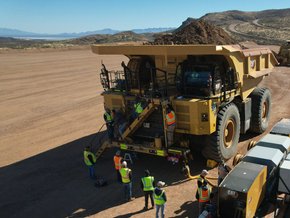Talent crisis 'a new top 10 risk' for mining industry

The talent crisis is a new 'top 10' risk for the mining industry according to KPMG's Global Mining Outlook 2022 report.
The annual report, now in its 12th year, draws on the insight and experience of KPMG professionals at member firms around the world, in addition to survey analysis from more than 300 sector executives in 23 key markets.
When asked about risks for their own specific organisation, executives ranked attracting and retaining talent at number seven.
"The workforce is an aging one and attracting a new generation of talent with the right skillsets for today’s shifting priorities, such as technology and ESG-related expertise, is challenging," the report states. "It’s an issue that confronts almost every player in the industry."
On the plus side, 62% of respondents were confident in the growth prospects for their organisation over the next 12 months, and more than 60% agree that mining companies need to embrace new business models, such as strategic partnerships, private equity and public-private partnerships.
Nearly three-quarters (72%) expect disruption in the mining sector due to ESG in the next three years, and almost half (46%) of respondents expect major technological innovation to disrupt the mining industry in the next three years. The top-ranked risk identified was environmental risks, including new regulations.
One important way of reducing carbon footprint is through the adoption of new technologies — with 87% of executives believing that technology has a key role to play in solving ESG challenges.
A resounding 84% believe technological disruption will be an "opportunity versus a threat" and similarly the global shift towards decarbonisation - while presenting inherent challenges to the industry - is driving growth and optimism.
Despite significant fluctuations, commodity prices remain at near all-time highs, driven by enormous growth in demand for minerals, including lithium, nickel, cobalt and graphite - all essential components in the global decarbonisation journey.
Trevor Hart, Global Head of Mining at KPMG International, said as the world’s supply chains look to meet rising demands, the mining industry finds itself increasingly in the spotlight, being challenged to quickly deliver the materials the world needs in a way that is acceptable to more and more stakeholders.
"In my view, transparency and high-quality engagement will be critical. For those who get it right, I believe the rewards will be significant," he said.
Katherine Wetmore, Risk Consulting Partner at KPMG in Canada, said: "Increased stakeholder interested in ESG targets and rising investor expectations are signs that mining businesses are having to change their focus and make longer-term commitments they’ve not had to make in the past.”
Ivan Mullany, Senior Vice-President of Projects at Newmont Corporation, said to get to a 30% carbon reduction by 2030, we need to bring more renewables into its business. "Doing that for our high carbon-emitting sites - converting them to wind or solar - will take us to that 30% target in combination with other efficiencies.”
Jeff Parr, Vice Chairman at Agnico Eagle Mines, said there is an opportunity for growth from embracing technology. "You don’t necessarily need to buy or find more ore. There’s technology emerging now that is starting to let us reduce cut-off grades, for example, and produce more of what we already have and do that profitably.”
Manuel Fernandes, Energy and Natural Resources Leader at KPMG in Brazil, added mining companies are not well-known as technological disruptors. "But there is a mandate now to invest more in technology to come up with solutions to the challenges of today — from ESG to productivity to ways of lowering costs.”
One striking note from this year’s research was the impact of COVID-19 completely disappearing from the top 10 risks identified by executives.
The industry, like most others, has adapted to the “new norm” from the pandemic, with some of the lasting effects remaining problematic for the sector, including increased global demand and supply chain issues.
However, the world is now looking towards an economic recovery and has developed a growing acceptance that more chronic international issues, including ESG, need to be tackled more proactively. Hart said for an industry that inherently operates over the long term, these shifts in a short space of time are striking.
"They underline the extent to which climate change-related issues and ESG more broadly are reframing corporate priorities in mining, as in almost every business sector," he said.
"They also influence the attractiveness of the industry to the new and diverse talent it requires. ESG is becoming ever more top of mind in mining company boardrooms, but this doesn’t mean that other opportunities and risks have fallen away. The risk is more around price volatility, with some marked swings of late challenging established LME trading systems, with temporary suspension of nickel trading as a result."
Political instability, nationalisation and the global trade conflict threat have all become front-line factors too.
The survey was carried out before the onset of the Ukraine war.
"I suspect that if we were to re-run it now, these risks would be appreciably higher still," added Hart. "From my observation, the opportunities for the industry are outstanding. The importance of the sector for the world’s future has been gaining more and more prominence and I believe it finds itself iin such a strong position to deliver.”






